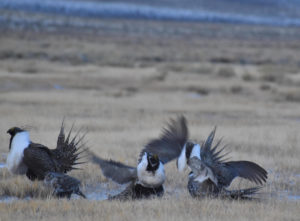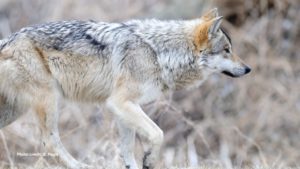For Immediate Release, April 27, 2023
Contacts:
Laura Cunningham, Western Watersheds Project, (775) 513-1280, lcunningham@westernwatersheds.org
Ileene Anderson, Center for Biological Diversity, (323) 490-0223, ianderson@biologicaldiversity.org
Lindsay Larris, WildEarth Guardians, (310) 923-1465, Llarris@wildearthguardians.org
WASHINGTON— The U.S. Fish and Wildlife Service announced today that it is reopening consideration of whether to list the bi-state sage grouse as endangered or threatened under the Endangered Species Act.
“Maybe the third time will be the charm for getting this population segment the protection it so clearly deserves,” said Laura Cunningham, California director of Western Watersheds Project. “None of the science shows that the bi-state birds have benefited from the Service’s dithering.”
Today’s announcement was spurred by a May 2022 court order that said the Service illegally withdrew its proposal to list the bird as threatened and required it to reconsider the species’ protection. It was the second time the agency’s refusal to protect the bird was overturned by the courts.
“This is a great opportunity to include the most recent science on bi-state sage grouse, who’re having a tough year with the epic snowfall in their habitat,” said Ileene Anderson, a senior scientist at the Center for Biological Diversity. “These beautiful dancing birds need help to stop sliding toward extinction. The Service’s reopening of its decision-making process is a step in the right direction.”
Bi-state sage grouse live in a small area along the California-Nevada border in the eastern Sierra Nevada on lands originally inhabited by the Washoe and Paiute peoples. The birds are genetically isolated from other populations of sage grouse elsewhere in the West.
There are only about 3,300 birds left — far fewer than the 5,000 considered the minimum for population viability. Sage grouse are threatened by climate change and habitat loss, livestock grazing and predation by ravens. A January 2020 study by the U.S. Geological Survey determined that while some centrally located populations of bi-state sage grouse were increasing, populations at the northern and southern end were at high risk of blinking out completely.
The birds were originally proposed for listing as threatened in 2013, but the Fish and Wildlife Service abandoned the proposal in 2015. In 2018 a federal court found the Service had wrongly denied Endangered Species Act protection to the bi-state sage grouse and required the agency to re-evaluate the bird’s situation. The bird was again proposed for protection, but in March 2020 the Trump administration withdrew the proposal.
“The political gamesmanship surrounding the bi-state sage grouse’s listing status is, sadly, not unique to this imperiled species,” said Lindsay Larris, wildlife program director at WildEarth Guardians. “We have seen far too many species stuck in extinction limbo for years before receiving protections that are obviously warranted based on the best available science. We are cautiously optimistic that the Service will now issue federal protections for the bi-state sage grouse so that it can finally begin a path towards recovery.”
Desert Survivors, the Center for Biological Diversity, Western Watersheds Project and WildEarth Guardians successfully challenged that withdrawal. In 2022 a judge reinstated the original proposal to list the birds as threatened and ordered the Fish and Wildlife Service to issue a new final listing decision.
Today’s announcement initiates a 60-day comment period.
###





